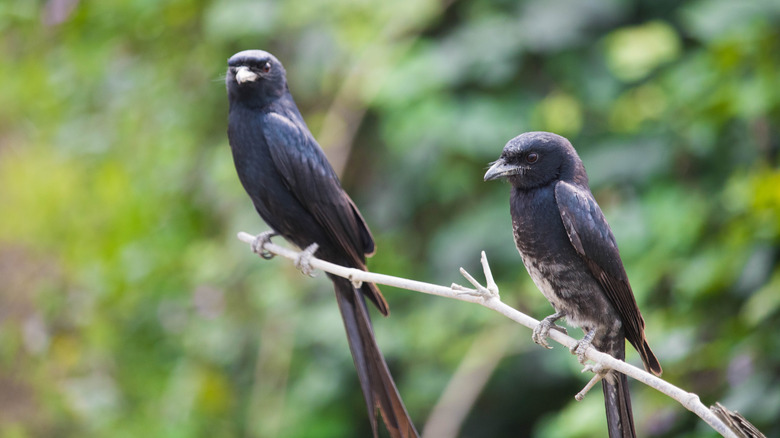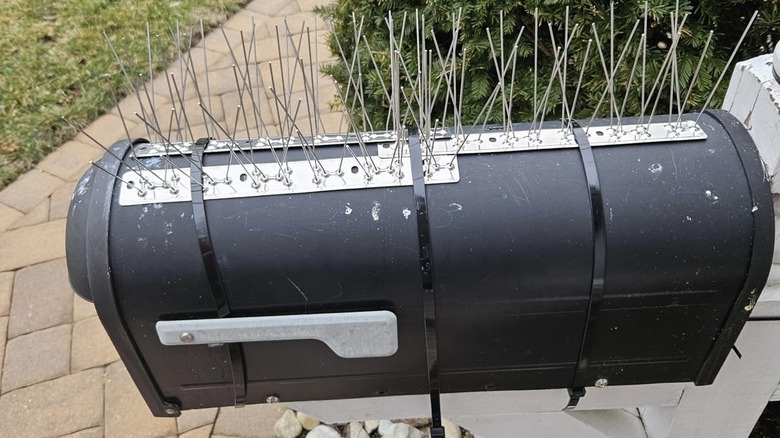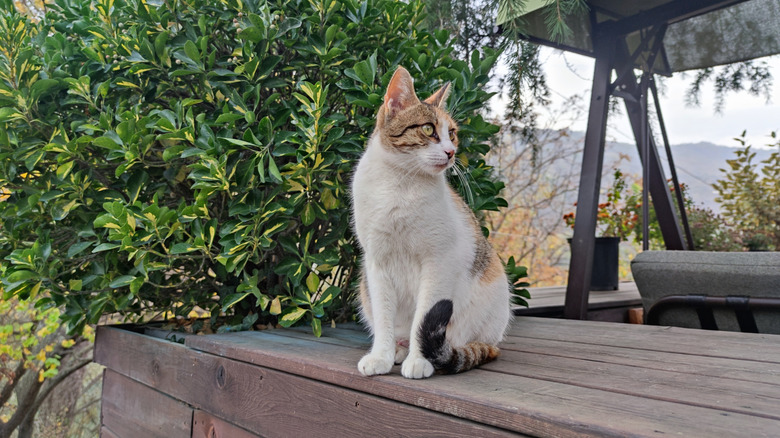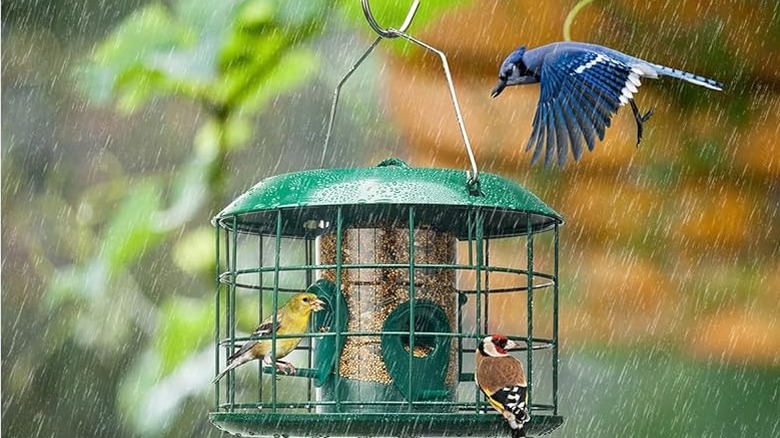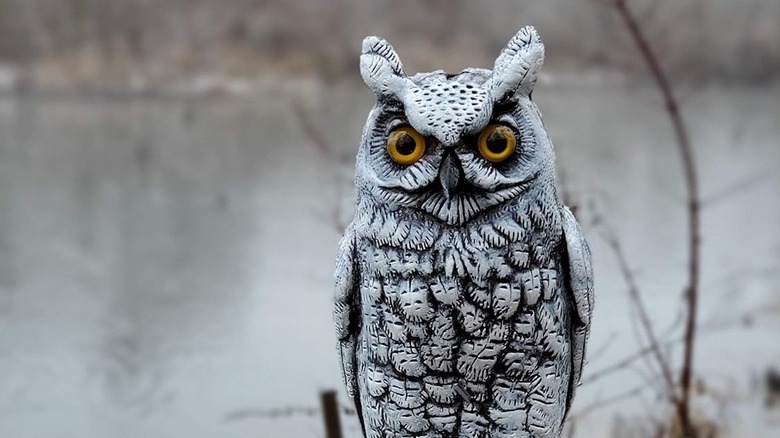Tips For Keeping Grackles Out Of Your Yard
We may receive a commission on purchases made from links.
Although common and great-tailed grackles are native throughout most of the United States, they're a bird species many people don't want to see in their yards. They're notorious for feasting on homegrown crops, hoarding food at bird feeders, squawking relentlessly, and being an overall nuisance on properties. Due to their overbearing nature, researchers and common people alike have found numerous humane methods to deter this bird species.
Below are ten tips for deterring grackles from your yard throughout the year. Many of these methods are usable alongside other home projects, easy to set up, and budget-friendly, giving homeowners an edge in driving out this overzealous bird species. Remember that although many of these tricks work at first, you might need to change up your methods and try other ploys over time. Like many bird species, Grackles are intelligent, and some of these deterrent methods may not fool them. In fact, they may realize your trick is no threat at all, making it ineffective at stopping their roosting, nesting, and feasting on your property.
Generally, the faster you drive out the grackles, the more effective your attempts will be. It's harder to deter birds the more comfortable they get, and it's borderline impossible if they've already built a nest and laid eggs. Read on to learn how farmers, gardeners, and homeowners alike deter grackles from their properties, how to replicate these methods, and any potential caveats you should be aware of.
Block grackles from accessing fruit and vegetable crops in your yard
All wild birds seek out three main things to survive: food, water, and shelter. When planting tasty fruits, seeds, and vegetables in a yard, specific bird species are drawn to their favorite foods. Grains like corn, rice, and wheat are common ingredients in grackle diets, as are fruits and vegetables like citrus, cantaloupe, figs, lettuce, tomatoes, and watermelon. When growing any of these crops on a landscape near local grackle populations, they must be sheltered from scavenging birds. Encase your plants with a frame with netting to protect them when they start producing fruits and vegetables. It directly blocks the birds' access to this potential food source, making your yard less appealing and sustainable as their permanent home (and keeping your harvest intact!).
Setting up a net frame is straightforward, and there are products intentionally designed for this purpose, such as the six-piece WYRJXYB Store 8-foot Greenhouse Hoops Grow Tunnel Set. A tunnel-style net frame is great for planter boxes and crops planted in traditional garden arrangements. Simply stake the hoops in the ground, pull the netting over top, and secure it using the included clips. You can also get something like the ZYP Large Fruit Tree Netting Covers for trees between about 6 to 10 feet tall. These nets are assembled in a similar fashion, and you may have to use a ladder to pull them over top a fruiting tree before zipping it up so grackles can't get to the developing produce.
Lay barriers that stop grackles from roosting along fencelines, roofs, and other outdoor structures
Grackles often perch on elevated structures and trees to give them a better vantage point and sense of safety while resting. The fewer spots they have to perch upon, the more exposed and unsafe they'll feel. This naturally makes them less likely to hang around a property. Invest in bird spikes to make common roosting spots uncomfortable for grackles. Lay the barrier along fences, the main house roof, shed roofs, windowsills, mailboxes, and anywhere else birds often rest.
There are multiple styles of bird spikes with alternative color schemes, designs, and sizes. The Offo Bird Spikes with Stainless Steel Base are available in sizes between 3.4 and 73.7 feet long and made of a durable metal material. The Ciic Plastic Bird Spikes are in sets of 20, 30, or 40 pieces, and have a less industrial look but are made of less long-lasting plastic. Verified purchasers report that either item works well to defend grackle-infested areas, though you may have to clean grass, leaves, twigs, and other nesting materials from them regularly.
Specialized bird spikes have a better reputation than non-specialized razor wire, which isn't designed to deter birds and has been proven ineffective in studies. Keep in mind that bird spikes won't prevent all bird species. Due to the spacing between spikes, smaller birds may actually be attracted to these products for nesting and roosting — it ironically creates a great foundation for their nests. Fortunately, this won't be an issue if you still want to attract more songbirds to your garden while deterring grackles and other medium to large-sized birds.
Water plants with grape-flavored water mixes that birds find unappealing
Many wild birds, including grackles, dislike the taste of methyl anthranilate. This is an additive commonly found in grape flavor, and when it's applied to produce in your garden, grackles will not be as fond of the taste. By spritzing fruits and vegetables with water mixed with grape flavor, the methyl anthranilate may be enough to keep unestablished populations of grackles away from your precious plants.
Put this tip into action as soon as the fruit begins to appear and attract grackles to your yard. Mix about five teaspoons Kool-Aid Caffeine Free Grape Sweetened Powdered Drink or another generic grape flavored drink powder with a gallon of water. Use this concoction to water your garden, dousing the leaves and fruits with a distasteful extra flavor. The beauty of this method is that it doesn't put your plants, household, or local wildlife at risk. Despite the intimidating name, methyl anthranilate has no toxic side effects and is safe and humane for discouraging bird populations.
As far as downsides go, you will have to reapply the solution every few days as new fruits appear and rain and wind wash away previous applications. If grackle populations are exceptionally high or you already had an issue with an excessive population before the fruits pop up, you'll likely need to pair this method with other ideas on this list.
Encourage outdoor cats to patrol areas where unwanted birds nest and roost
There's a reason so many YouTube videos for cats contain grackles in their feeds– cats hunt this wild bird species. If you own an outdoor cat or your neighborhood is home to strays, put the felines to work deterring local grackle populations. Give cats access to roofs, rafters, and other spots grackles enjoy nesting on your property. If predators routinely patrol and lounge in these areas, birds will think twice about making it their home.
Order specialized products for cats to climb, such as these Ewenono Cat Wall Shelves/Cat Stairs, or this Agricue Sisal Rope Cat Bridge, or build your own siding ladders, shelves, ramps, or stairs using affordable but resilient lumber from home improvement stores like Lowe's Rough Cedar Green Lumber. There are many tutorials online, such as Cuckoo 4 Design's DIY outdoor cat ladder.
The only caveat to an exterior catwalk is that it does invite cats onto your property. If you don't want your cat climbing to dangerous heights, or you don't want to make an inviting landscape for strays, this hack won't work to your benefit. Another factor to remember is that cats won't specifically target grackles. They'll target all birds, and may drive away the types of birds you do want in your yard.
Make bird feeding areas impractical for grackles to enjoy
Many people seek out ways to intentionally attract birds to their yards. When drawing in desired birds, unfavorable species also tend to pop up. Grackles dominate standard bird feeder designs, pushing aside smaller bird species to take most of the food. Make it harder for them to tyrannize a bird feeder setup by investing in a grackle-proof design. Look for options with smaller perches, exterior cages, weighted perches, upside-down suet holders, or a tubed feeder that attracts smaller birds while keeping away bigger ones. The Sky Cafe Squirrel Proof Bird Feeder pairs with a Sky Cafe Dove Guard to keep unwanted birds out. This contraption seems to work for the intended species, doves, as well as grackles. One reviewer shared, "We did add the dove guard to keep grackles and doves off. So we are very pleased with this feeder."
In addition to picking a grackle-resistant bird feeder design, intentionally use feed that doesn't appeal to grackles. Common grackles aren't usually interested in safflower, milo sorghum, thistle, unshelled peanuts, or suet-style birdfeed, so you should look for mixtures with these ingredients. On the other hand, you might want to avoid birdseed mixes with corn, millet, sunflower seeds, and peanut hearts, as these are foods that grackles are known to prefer. The More Birds Squirrel-X Double Suet Feeder has a cage that blocks grackles and a suet-style bird food holder, making it twice as unappealing to this unwanted bird species.
Keep in mind that if grackles are hungry or stubborn, mediocre food in a tricky bird feeder won't be enough to deter them. They may still find a way to perch and awkwardly peck at the birdseed that's nearly out of reach. If they're hungry, they may settle for ingredients they wouldn't normally go for either.
Set up reflective objects in your yard that confuse and deter passing birds
There is some debate about whether reflective objects deter birds. While setting up items that reflect sunlight and glint around your yard can deter passing birds, it may not be effective long-term if neighborhood birds grow used to the flashes. Many people set up monofilament lines or specially designed products that glint in sunlight, confusing birds and making them uncertain if they want to enter a space.
According to James E. Knight, an extension wildlife specialist, monofilament (or fishing) line deters birds, but not for any confirmed reason. He shares speculations that it creates visual uncertainty when shining in the light. You grab a roll of fishing line (like this Stren Original Monofilament Fishing Line) and string it up between trees or structures, try a device deliberately designed to ward off birds, like Bird B Gone Reflective Spinning Deterrent, or even experiment with using aluminium foil to keep birds out of fruit trees and grackles out of your garden. Monofilament has proven effective for deterring grackles in citrus orchards and reducing crop losses — but, unfortunately, it's not target-specific.
In addition to being potentially short-lived, this grackle-deterrent isn't solely directed at grackle species. It may deter other birds from your yard, too, making it an unwise choice for people with bird feeders and bird bath setups. If you don't want birds entering specific parts of your yard (like a veggie patch), lay fishing lines or reflective products in those areas.
Keep an orderly landscape with few nesting spots and materials for grackles
An indirect method for dissuading grackles from nesting on your property is to make your overall landscape less appealing. The more lawn and grass space there is, the fewer resources and shelters they can use. Also remove fallen debris so grackles have fewer resources with which to build their homes.
You can start by planning some empty space between pockets of foliage and flowers so birds feel less sheltered from predators on your lawn. You might also want to avoid growing grackle-preferred plants, such as sunflowers and honeysuckles, since grackles feast on sunflower seeds and build nests with honeysuckle vines. Since common grackles are known for nesting in evergreen, vining, and dense foliage, look for plants at local nurseries with none of those characteristics.
In addition to planning a garden that's less enticing, maintain the overall landscape to keep it undesirable for grackles. Always clean up after storms and drastic seasonal changes, removing, disposing, or composting natural resources that grackles would otherwise use to build nests. Grackle nests are often made of vine-like materials, and you should also prioritize removing overgrown grass pieces, weeds, rushes, and fallen twigs they could use.
Always clean up after spending a day outdoors
Having a beautiful yard, landscape, and outdoor seating area is something to be proud of. There are many birds that have no interest in human trash, leftover food, and other debris. Grackles are not those birds — if you host guests or spend a day with your housemates outdoors, leaving leftover food on outdoor kitchen counters, grills, and tabletops may attract these pesky avians. It's even more likely when guests feed grackles during outdoor festivities. Grackles are omnivores, and they aren't picky about what they eat. In fact, they have a sucrose enzyme that isn't active in many bird species making it easier for them to digest processed food.
Don't let local grackle populations flock to your home for leftovers. Be diligent in storing leftover food, scrubbing down tables, grills, and countertops, and ensuring you tightly seal or empty trash cans before going inside. Outdoor fridges are airtight, and grackles don't have the biological ability to open the door, but be wary about outdoor pantries. Again, these birds are smart – they've been spotted stealing ingredients sealed in paper and disintegrating the paper in water so they can feast on the food inside. You may think pantry items are safe, but if given enough time, grackles may learn how to pry these items open and share their findings with the rest of their flock. Make sure outdoor cabinets have locking mechanisms or put food in plastic Tupperware in addition to the original packaging.
Create the illusion that grackle predators lurk on your property
Although grackles are larger than many songbird species, they aren't at the top of the food chain. Cats, chipmunks, hawks, owls, raccoons, snakes, and squirrels predate on this common bird species. Grackles are wary of their surroundings, and you may be able to trick them into avoiding your yard by creating the illusion of a predator's presence with statues. Since grackles aren't easily fooled, you'll need to move the statue around and choose one that rotates its head and has a more realistic appearance.
Put up a predator statue where grackles often roost on your property, and make sure you pick a statue that emulates their natural predators. The Hedoc 2 Pack Fake Owl Decoys are about a foot tall and have heads that rotate using an implemented wind vane mechanism. There are mixed reviews on how well this product and the Dalen Large Owl Decoy, a similar predator statue in Great Horned Owl or Snow Owl form, work on grackles. However, it still might be worth a shot.
YouTuber It's Just Gardening warns that this trick works short-term, and kept grackles off their property for about a month before they had to switch up its location. This method is also known to be less effective if grackles are already nesting and have an established home since they aren't going to flee from their natural predators if they have baby birds in a nearby nest. Given these factors, your best bet is to start setting up owls before spring and keep them moving every month to stop grackles from realizing the truth behind a decoy.
Trick grackles with recorded sounds that frighten them
Since they're prey to many species, grackles' survival instincts can be triggered by sounds in their environment. When they hear distress calls from their own species followed by the threatening calls of a predator, this may discourage them from making a yard their home. There have been university studies on BirdXPeller-branded sound devices that find them effective for most bird species aside from woodpeckers.
If you want a convenient solution, you can try an electronic sonic bird decoy device, like Bird-X BirdXPeller Pro Electronic Bird Preventer Version 1. Make sure to install it in a spot sheltered from rain and near a targeted grackle infestation. There are eight audio options, and you should choose a combination of bird distress calls (options one through six) and predator calls (options two, seven, and eight). YouTuber Next Level DIY recommends changing the distress calls every other day, adjusting the volume, and moving the box to different areas to "keep these birds on their toes." If you don't want to invest in a specialized product, you can also set up outdoor speakers that sound like grackles' common predators, such as hawks or owls. There are YouTube compilations, like PMnaturaly's video for scaring birds, that are playable through speaker setups.
